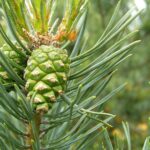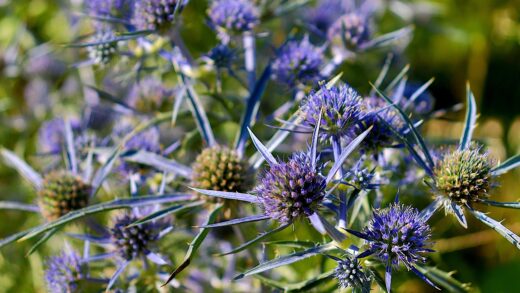Rosemary is a remarkably resilient and robust herb, naturally protected from many common garden afflictions by the aromatic essential oils present in its foliage. These oils act as a deterrent to many grazing animals and insect pests. However, despite its hardy nature, rosemary is not entirely immune to problems, particularly when its specific cultural requirements are not met. The most significant threats to its health are not aggressive pathogens or pests, but rather environmental conditions that create an opportunity for them to take hold. Most diseases and pest infestations on rosemary can be directly linked to issues such as poor air circulation, overwatering, or inadequate sunlight, making preventative care the most effective form of defense.
Fungal diseases
By far the most common diseases to affect rosemary are fungal in nature, and they are almost always a consequence of excessive moisture and poor air circulation. Powdery mildew is one of the most frequently encountered issues. It appears as a white, dusty, or powdery coating on the surfaces of the leaves and stems. While it may not kill the plant outright, a severe infection can impede photosynthesis, causing leaves to yellow and drop, and ultimately weakening the plant. Powdery mildew thrives in conditions of high humidity and stagnant air, making overcrowded plants or those kept in humid indoor environments particularly susceptible.
Root rot is the other major fungal threat to rosemary, and it is far more deadly than powdery mildew. This disease is not caused by a single pathogen but can result from several different soil-borne fungi, such as Phytophthora or Pythium. These fungi flourish in anaerobic, waterlogged soil conditions. The disease attacks the plant’s root system, causing it to decay and become unable to absorb water and nutrients. The above-ground symptoms are often misleading, as the plant will wilt, yellow, and appear thirsty, potentially prompting a gardener to water it even more, thus exacerbating the problem. By the time these symptoms are obvious, the root damage is often extensive and irreversible.
Preventing fungal diseases is significantly more effective than attempting to cure them. To prevent powdery mildew, ensure the plant has ample space for air to circulate freely around it. Pruning to thin out dense growth can also help. When watering, apply water directly to the soil at the base of the plant to keep the foliage as dry as possible. For root rot, the preventative measures are even more critical: use a very well-draining soil mix, choose a pot with adequate drainage holes, and always allow the soil to dry out between waterings.
If powdery mildew does appear, it can sometimes be managed by improving air circulation and applying a fungicide. Neem oil or a solution of potassium bicarbonate can be effective as an organic treatment if applied at the first sign of the disease. For root rot, however, treatment is rarely successful. The best hope is to remove the plant from the pot, trim away all of the rotted, mushy roots with a sterile tool, and repot it into fresh, dry, sterile soil. Even with these measures, the prognosis for recovery is often poor.
Common insect pests
While rosemary’s strong scent repels many insects, there are a few pests that may still take up residence on the plant, especially if it is stressed or grown indoors. Aphids are small, pear-shaped, sap-sucking insects that can congregate on the tender new growth at the tips of the stems. They feed by piercing the plant tissue and extracting the nutrient-rich sap. A large infestation can cause new growth to become stunted, yellowed, or distorted. Aphids also excrete a sticky substance called honeydew, which can lead to the growth of sooty mold.
Spider mites are another potential pest, particularly in hot, dry indoor environments with poor air circulation. These tiny arachnids are difficult to see with the naked eye, but their presence is often revealed by fine, silky webbing on the undersides of leaves and between branches. They also feed on plant sap, causing the leaves to develop a stippled or speckled appearance as small yellow or white dots appear. A severe infestation can cause leaves to turn yellow or bronze and drop from the plant.
Spittlebugs are a common but largely cosmetic pest of rosemary grown outdoors. The presence of these insects is easily identified by the frothy, spit-like masses they create on the plant’s stems. Inside this “spittle,” the nymph stage of the insect is protected from predators and dehydration while it feeds on the plant’s sap. While the spittle masses are unsightly, the feeding activity of the spittlebug nymphs rarely causes any significant or lasting damage to a healthy rosemary plant.
Another pest to watch for, especially on indoor plants, is the scale insect. These pests appear as small, immobile bumps on the stems and undersides of leaves. They have a waxy, protective coating that shields them from many predators and pesticides. Like aphids, they feed on sap and can weaken the plant over time, causing yellowing leaves and reduced vigor. Their presence can be difficult to notice until the infestation becomes significant.
Pest management and control
The first line of defense against pests is to maintain a healthy and vigorous plant. Pests are more likely to attack plants that are already stressed by poor growing conditions. Providing adequate sunlight, proper watering, and good air circulation will make a rosemary plant much more resilient to infestations. Regularly inspecting the plant, including the undersides of leaves and the junctions of stems, can help to catch any pest problems early before they become widespread.
For minor infestations of pests like aphids and spider mites, physical removal can be an effective first step. A strong jet of water from a hose can dislodge many of the insects from the plant. This is best done in the morning to allow the foliage to dry quickly. For indoor plants, wiping the pests off with a cloth or a cotton swab dipped in rubbing alcohol can also be effective, particularly for scale insects, whose waxy coating can be dissolved by the alcohol.
If a pest problem persists, insecticidal soaps or horticultural oils, such as neem oil, are good organic control options. These products work by smothering the soft-bodied insects and disrupting their life cycle. They are most effective when applied thoroughly, ensuring complete coverage of all plant surfaces, especially the undersides of the leaves where many pests hide. Multiple applications may be necessary, typically spaced a week or two apart, to control newly hatched pests.
In the case of spittlebugs, the simplest and most effective method of control is to simply wash the frothy masses off the plant with a jet of water. Since the damage they cause is minimal, this is usually all that is required. For all pest issues, the use of broad-spectrum chemical pesticides should be a last resort, especially on a culinary herb like rosemary. These chemicals can harm beneficial insects and pollinators and are often unnecessary for controlling the common pests that affect this plant.
Environmental stress factors
It is important to recognize that many symptoms that may appear to be caused by a disease or pest are actually physiological responses to environmental stress. As previously mentioned, yellowing leaves are far more likely to be a sign of overwatering than any other issue. A healthy root system is the foundation of a healthy plant, and any problem that compromises the roots will manifest in the foliage. Therefore, investigating soil moisture should always be the primary diagnostic step.
Leaf drop is another common symptom that can be attributed to several stress factors. A rosemary plant that is suddenly moved from a bright outdoor location to a lower-light indoor environment for the winter will often drop a significant number of its inner leaves as it acclimates to the reduced light levels. Similarly, sudden changes in temperature or exposure to cold drafts can also cause the plant to shed foliage. This is a stress response rather than a sign of a disease.
Brown or brittle leaf tips are often a sign of underwatering, where the plant is not receiving enough moisture to keep all of its foliage hydrated. However, it can also be a symptom of a high concentration of salts in the soil, which can occur in container-grown plants that are frequently fertilized with tap water. This salt build-up can “burn” the tips of the leaves and can be remedied by flushing the soil thoroughly with water.
Ultimately, the best defense against all of these problems—diseases, pests, and environmental stress—is to provide the plant with the conditions it has adapted to. A location with at least six hours of direct sun, a gritty and fast-draining soil, deep but infrequent watering, and good air circulation will prevent the vast majority of issues that can affect rosemary. A healthy plant has strong natural defenses and is far less likely to succumb to any of these potential afflictions.
Prevention as the primary strategy
The overarching theme in managing rosemary’s health is that prevention is vastly superior to treatment. Creating a growing environment that mirrors its native Mediterranean habitat is the single most effective action a gardener can take. This proactive approach begins with the initial planting, ensuring the soil is amended for perfect drainage and the location receives ample sunlight. These two factors alone will prevent the most common and fatal problems, namely root rot and weak, etiolated growth.
Regular and appropriate pruning also plays a crucial preventative role. By selectively thinning out branches, especially in the center of the plant, air is able to move freely through the foliage. This simple practice dramatically reduces the humidity within the plant’s canopy, creating an environment that is inhospitable to fungal spores like powdery mildew. It also allows sunlight to penetrate deeper into the plant, promoting stronger, healthier growth throughout the entire shrub.
Careful observation is another key component of a preventative strategy. By regularly inspecting the plant, a gardener can spot the very first signs of trouble, whether it is the white dust of powdery mildew, the first few aphids on a new shoot, or the slight yellowing of a lower leaf. Early detection allows for immediate and gentle intervention, such as wiping off a few pests by hand or adjusting the watering schedule, which can prevent a minor issue from escalating into a major problem that requires more drastic measures.
Finally, a preventative mindset involves resisting the temptation to over-care for the plant. This means not overwatering, not over-fertilizing, and not panicking at the first sign of a yellow leaf. Understanding that rosemary is a tough and resilient plant that thrives on a bit of neglect is essential. By providing the right foundational conditions and then allowing the plant to grow with minimal interference, a gardener is creating the strongest possible defense against the diseases and pests that might otherwise affect it.




















